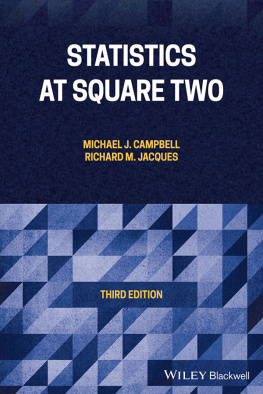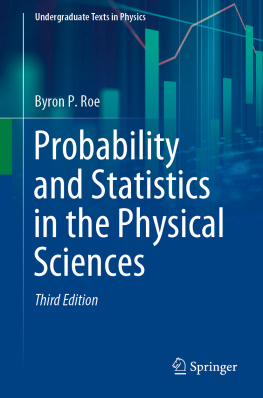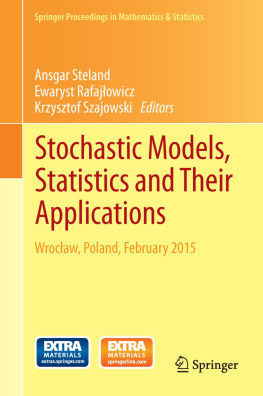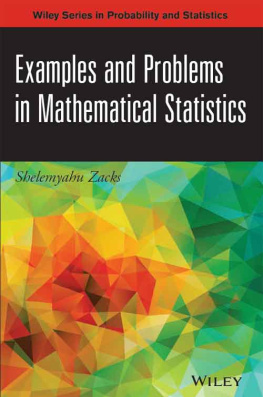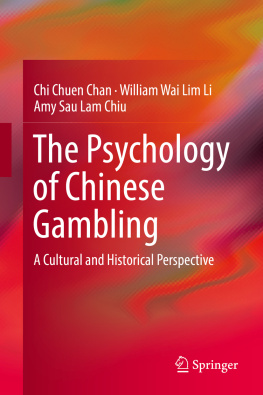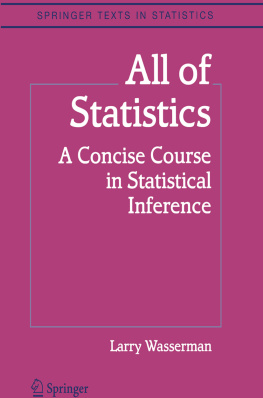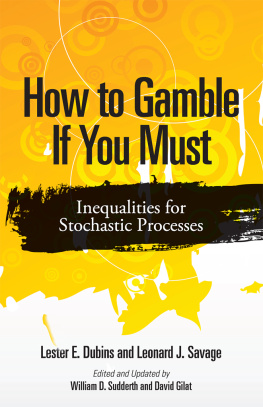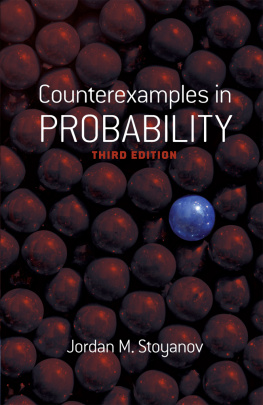How to Gamble If You Must
Inequalities for Stochastic Processes
Lester E. Dubins
Leonard J. Savage
Edited and Updated by
William D. Sudderth
School of Statistics
University of Minnesota
David Gilat
Department of Statistics and Operations Research
School of Mathematical Sciences
Tel Aviv University
Dover Publications, Inc.
Mineola, New York
Copyright
Copyright 1965 by Lester E. Dubins and Leonard J. Savage
Copyright 1976 by Lester E. Dubins
Copyright 2014 by Dover Publications, Inc.
All rights reserved.
Bibliographical Note
This Dover edition, first published in 2014, is an unabridged republication of the corrected 1976 Dover edition entitled Inequalities for Stochastic Processes which contained a new Bibliographic Supplement and a new Preface by Lester E. Dubins. The book was originally published as How to Gamble If You Must: Inequalities for Stochastic Processes in 1965 by the McGraw-Hill Book Company, Inc., New York. This 2014 edition contains a new Preface, an additional bibliographic supplement, Remarks on Open Problems, an Appendix on Finite Additivity, and an About the Authors page. All new material was provided by William Sudderth and David Gilat.
Library of Congress Cataloging-in-Publication Data
Dubins, Lester E., 1920
How to gamble if you must: inequalities for stochastic processes / Lester E. Dubins and Leonard J. Savage; edited with a new preface by William D. Sudderth and David Gilat.Dover edition.
p. cm.
Originally published in 1965 as: How to gamble if you must. Republished in 1976 as: Inequalities for stochastic processes.
Includes bibliographical references and index.
eISBN-13: 978-0-486-79608-6
1. Games of chance (Mathematics) 2. Gambling. 3. Stochastic inequalities. I. Savage, Leonard J. II. Sudderth, William D. III. Gilat, David (Mathematics professor) IV. Dubins, Lester E., 1920 Inequalities for stochastic processes. V Title. VI. Title: Inequalities for stochastic processes.
QA273.D77 2014
519.23dc23
2014008632
Manufactured in the United States by Courier Corporation
78064301 2014
www.doverpublications.com
TO OUR FATHERS
About the Authors
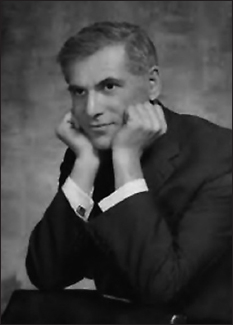
Lester Eli Dubins
(April 27, 1920 February 11, 2010)
Born and raised in New York. His college education was interrupted by World War II, in which he served as an Air Force officer stationed in Iceland. After the war he continued to work for several years as a civilian on radar research and development for the Air Force, but then resumed his studies at the University of Chicago as a graduate student of mathematics, obtaining his Ph.D in 1955 under the guidance of Irving Segal. After a year at the Institute for Advanced Study in Princeton and a few years at the Carnegie Institute of Technology in Pittsburgh, he joined the University of California at Berkeley in 1960, where he remained for the rest of his career as Professor of Mathematics and Statistics. Although noted primarily for his research in probability theory, scattered among his nearly one hundred scholarly publications are numerous papers on a wide range of mathematical themes, such as curves of minimal length under constraints on curvature and initial and final tangents (to be known as Dubin paths), Tarski circle squaring problem, convex analysis, and a variety of topics in topology and geometry.
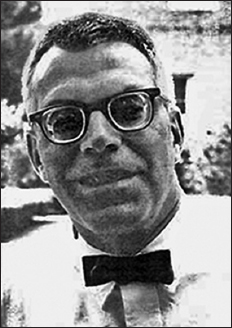
Leonard Jimmie Savage
(November 20, 1917 November 1, 1971)
Born and raised in Detroit. His severely poor eyesight from early childhood did not deter him from rising to substantial intellectual and scientific accomplishments. After obtaining a Ph.D degree in Mathematics from the University of Michigan in 1941, he spent a year at the Institute for Advanced Study in Princeton solving a problem in the Calculus of Variations suggested to him by John von Neumann. At von Neumanns recommendation, Savage joined the Statistical Research Group at Columbia University in New York, engaged in those days to work for the war effort. After the war, in 1946, he joined the University of Chicago and in 1949 became one of the founders of its Statistics Department, serving as chairman of the department from 1956 to 1959. His most noted (and controversial) work was the 1954 book Foundations of Statistics which lays out his theory of utility, subjective probability, and Bayesian statistics. His staunch insistence on Bayesianism as the only sound approach to statistics alienated him from large circles in the statistical community. In 1960 he left Chicago to take up a professorship at the University of Michigan where he remained for four years before moving to Yale University to become the Eugene Higgins Professor of Statistics. Sadly, he had only seven years at Yale before his sudden premature death.
The collaboration of the authors which led to this book is presented in the preface to the first Dover edition.
Preface to the Second Dover Edition
The previous Dover edition appeared in 1976, five years after the untimely death of Leonard J. Savage at the age of 54. In his impressive preface to the 1976 edition of the book, Lester Dubins pays tribute to his friend Jimmie Savage - to his remarkable intellect and scholarship as well as to their mutual friendship and mathematical collaboration. Having also praised Savages outstanding writing skills, Dubins - alluding to the bibliographic supplement appended to the new edition - concludes his preface by saying: .. reading some of the references will, I hope, enable the reader to visualize, at least in outline form, the kind of revision that might be possible were there alive my much missed friend, Leonard Jimmie Savage.
Lester Eli Dubins died in 2010 and it was his wish, stated explicitly in his will, that in any further edition of the book, the text - as originally composed by him and Savage - be left intact. In adherence to this wish, the present edition is identical with the preceding one, except for the following, hopefully useful, additions:
1. A Bibliographic Supplement (2014) listing, to the best of our ability, the relevant literature that has appeared during the 38 years since the publication of the previous edition.
2. Remarks on Open Problems: Dubins and Savage leave many open problems scattered throughout the book which they list at the end. Some of these problems have been partially or completely solved over the years. We briefly discuss some of the solutions and in each case point to the relevant references in the bibliographic supplement.
3. Appendix on Finite Additivity. Readers who are used to the conventional, countably additive approach to probability may have difficulty with the (more general) finitely additive framework used in the book. The main purpose of this appendix is to provide a simple introduction to the finitely additive probability theory needed to understand the statements and proofs in the book. The appendix was written in collaboration with Roger Purves.
We feel that the title, How to Gamble if You Must, of the original 1965 edition of the book, better reflects its content and its authors intention than the subtitle Inequalities for Stochastic Processes


